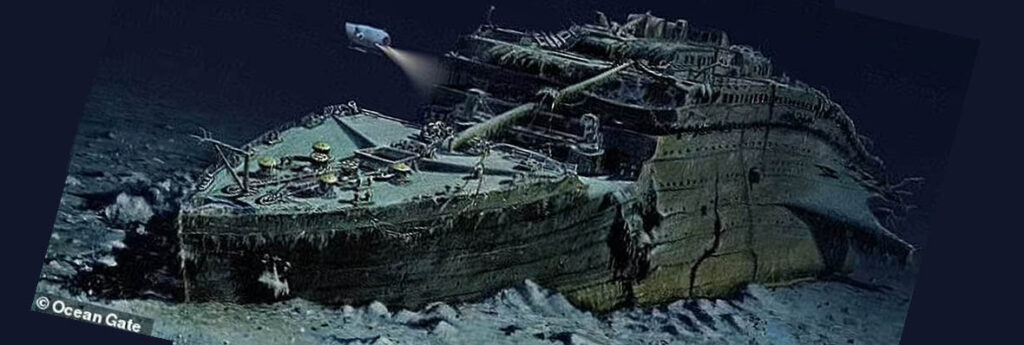A rescue operation was underway deep in the waters of the Atlantic Ocean off the coast of Newfoundland on Monday in search of a submarine that carries tourists to view the wreckage of the Titanic.
The Joint Rescue Coordination Centre in Halifax says the small research submersible, called Titan, was reported overdue around 9:13 p.m. Sunday, about 700 km south of St. John’s.
Lt.-Cmdr. Len Hickey says an Aurora military aircraft and the Canadian Coast Guard vessel Kopit Hopson are assisting the search effort, which is being led by the US Coast Guard in Boston.
Chief Mi’sel Joe, who is head of the Newfoundland and Labrador Mi’kmaq band that owns the ship from which the small submarine is launched, confirms it is operated by OceanGate Expeditions.
The carbon-fiber submersible carried a pilot, a renowned British adventurer, two members of an iconic Pakistani business family and another passenger.
Every passing minute puts the Titan’s crew at greater risk. The submersible had a 96-hour oxygen supply when it put to sea at roughly 6 a.m. Sunday, according to David Concannon, an adviser to OceanGate.
“It is a remote area – and it is a challenge to conduct a search in that remote area,” said Rear Adm. John Mauger, a commander for the U.S. Coast Guard, which also is searching for the Titan. “But we are deploying all available assets to make sure we can locate the craft and rescue the people on board.”
The Canadian research icebreaker Polar Prince, which was supporting the Titan, reportedly lost contact with the vessel about an hour and 45 minutes after it submerged. The Polar Prince was to continue to do surface searches throughout the night and a Canadian Boeing P-8 Poseidon reconnaissance aircraft will resume their surface and subsurface search in the morning, the US Coast Guard said on Twitter. Two US Lockheed C-130 Hercules aircraft also have conducted overflights.
Ship-tracking satellite data from MarineTraffic.com showed the Polar Prince some 690 km southeast of St. John’s on Tuesday morning.
OceanGate’s expeditions to the Titanic wreck site include archaeologists and marine biologists. The company also brings people who pay to come along, known as “mission specialists.” They take turns operating sonar equipment and performing other tasks in the five-person submersible.
OceanGate said its focus was on those aboard and their families.
British businessman Hamish Harding, who lives in Dubai in the United Arab Emirates, was one of the mission specialists, according to Action Aviation, a company for which Harding serves as chairman.
Harding is a billionaire adventurer who holds three Guinness World Records, including the longest duration at full ocean depth by a crewed vessel. In March 2021, he and ocean explorer Victor Vescovo dived to the lowest depth of the Mariana Trench. In June 2022, he went into space on Blue Origin’s New Shepard rocket.
The expedition was OceanGate’s third annual voyage to chronicle the deterioration of Titanic, which struck an iceberg and sank in 1912, killing all but about 700 of the roughly 2,200 passengers and crew. Since the wreckage’s discovery in 1985, it has been slowly succumbing to metal-eating bacteria. Some have predicted the ship could vanish in a matter of decades as holes yawn in the hull and sections disintegrate.
The initial group of tourists in 2021 paid $100,000 to $150,000 apiece to go on the trip. OceanGate’s website had described the “mission support fee” for the 2023 expedition as $250,000 a person.
Unlike submarines that leave and return to port under their own power, submersibles require a ship to launch and recover them.
OceanGate hired the Polar Prince to ferry dozens of people and the submersible craft to the North Atlantic wreck site. The submersible would make multiple dives in one expedition.
The expedition was scheduled to depart from St. John’s, Newfoundland, in early May and finish up at the end of June, according to documents filed by the company in April with a US District Court in Virginia that oversees Titanic matters.
CBS journalist David Pogue, who went on the trip last year, noted his vessel got turned around looking for the Titanic.
“There’s no GPS underwater, so the surface ship is supposed to guide the sub to the shipwreck by sending text messages,” Pogue said in a segment aired on CBS Sunday Morning. “But on this dive, communications somehow broke down. The sub never found the wreck.”
The submersible, named Titan, is capable of diving 4 km “with a comfortable safety margin,” OceanGate said in its court filing.
It weighs 9,072 kg in the air, but is ballasted to be neutrally buoyant once it reaches the seafloor, the company said.
Experts said Monday that rescuers face steep challenges.
Alistair Greig, a professor of marine engineering at University College London, said submersibles typically have a drop weight, which is “a mass they can release in the case of an emergency to bring them up to the surface using buoyancy.”
“If there was a power failure and/or communication failure, this might have happened, and the submersible would then be bobbing about on the surface waiting to be found,” Greig said.
Another scenario is a leak in the pressure hull, in which case the prognosis is not good, he said.
“If it has gone down to the seabed and can’t get back up under its own power, options are very limited,” Greig said. “While the submersible might still be intact, if it is beyond the continental shelf, there are very few vessels that can get that deep, and certainly not divers.”
Even if they could go that deep, he doubts they could attach to the hatch of OceanGate’s submersible.

